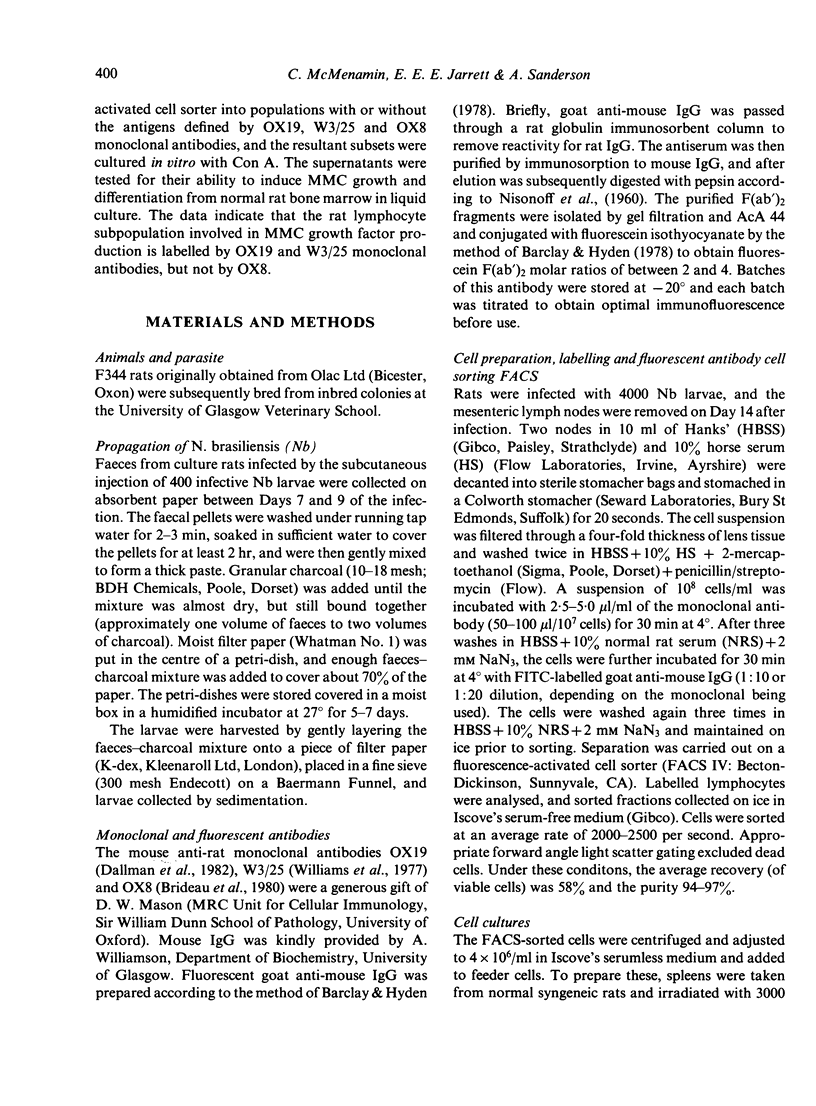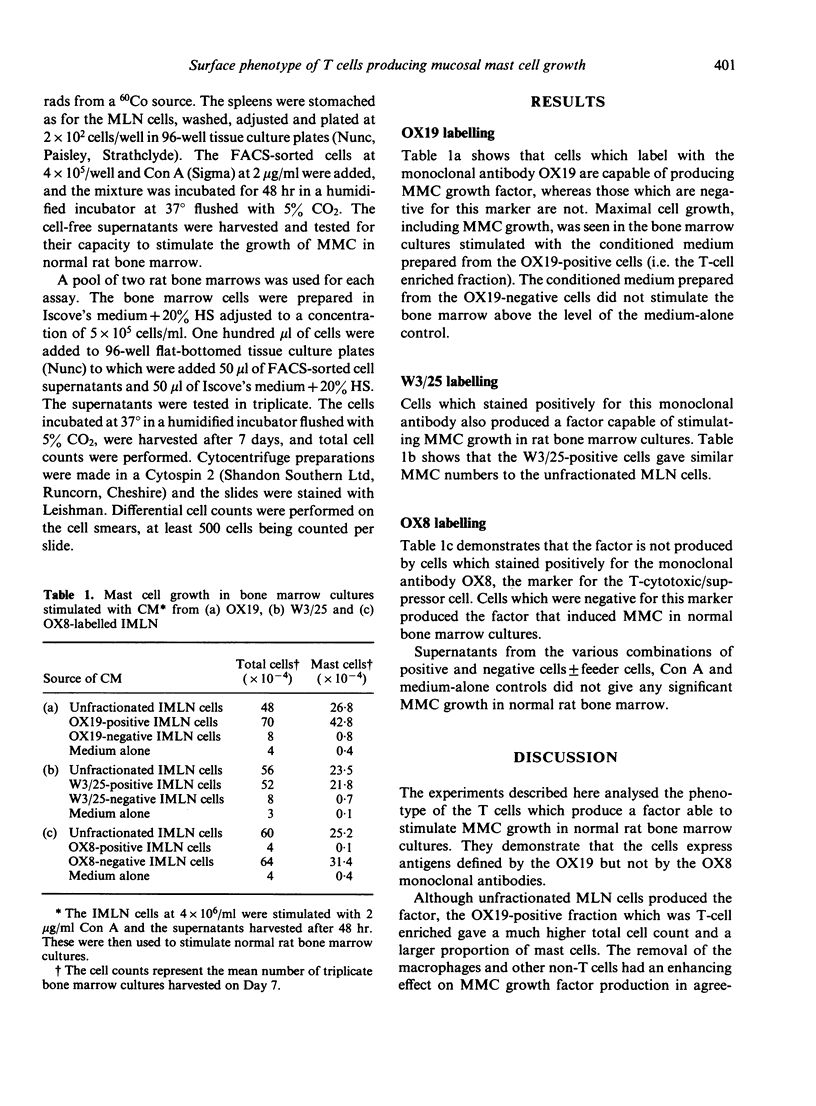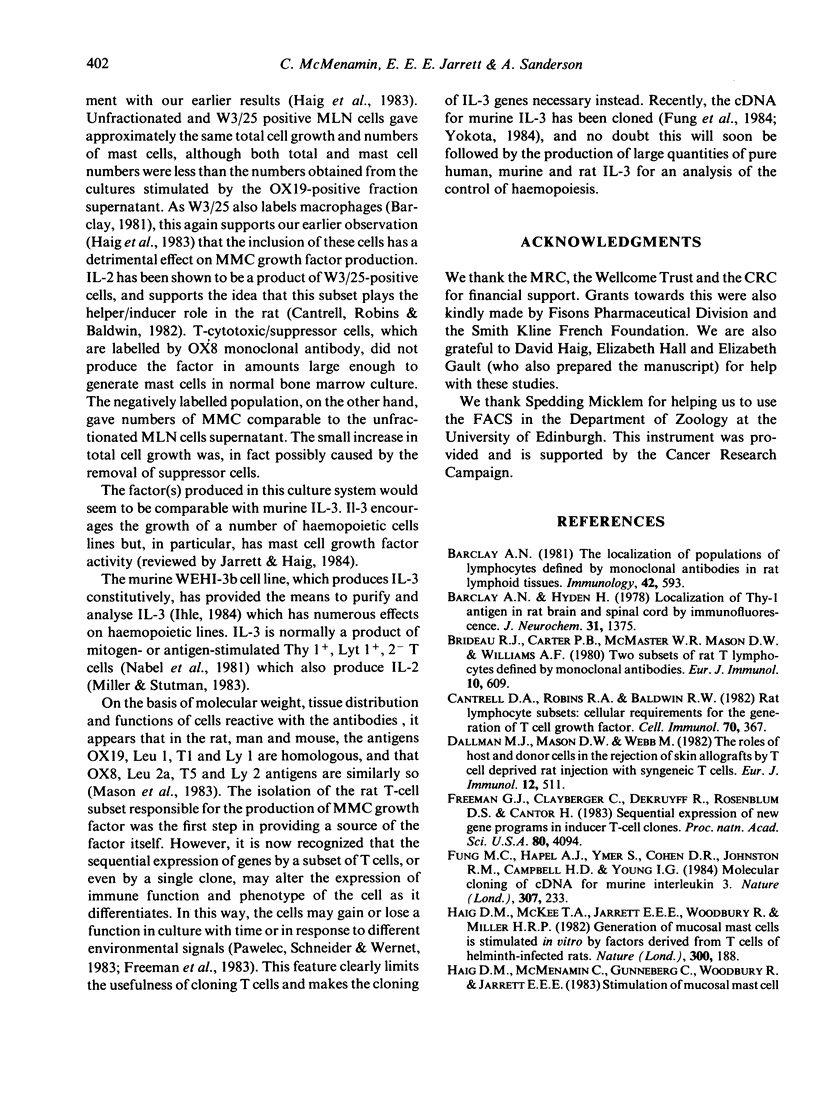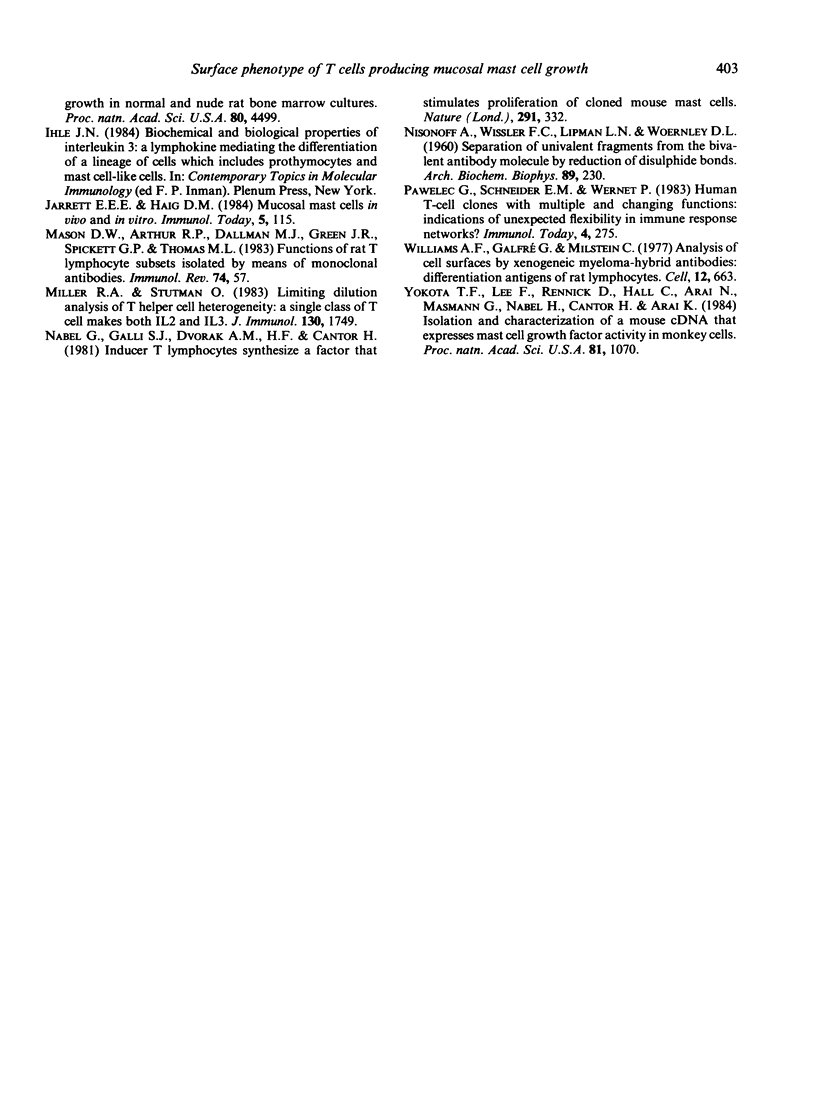Abstract
We have previously shown that lymphocytes from Nippostrongylus brasiliensis infected rats, when stimulated with antigen or concanavalin A (Con A) release factors which are comparable with murine IL-3. On addition of these factors to rat bone marrow cultures, mast cells with the morphological and biochemical properties of mucosal mast cells (MMC) proliferate and mature. Here, we use this system, along with monoclonal antibodies against rat T cells and the fluorescence-activated cell sorter (FACS), to isolate the subset of T cells responsible for the production of this MMC growth factor. Lymphocytes from N. brasiliensis infected rats were separated on the FACs into populations with and without the antigens defined by OX19, W3/25 and OX8 monoclonal antibodies; these antibodies label all T cells, T-helper cells and T-cytotoxic/suppressor cells, respectively. The resultant subsets were cultured in vitro with Con A. The supernatants were tested for the ability to induce MMC growth and differentiation in liquid cultures of normal rat bone marrow. The phenotype of the T cells producing this factor was established as being OX19+, W3/25+ and OX8-.
Full text
PDF




Selected References
These references are in PubMed. This may not be the complete list of references from this article.
- Barclay A. N., Hydén H. Localizatin of the Thy-1 antigen in rat brain and spinal cord by immunofluorescence. J Neurochem. 1978 Dec;31(6):1375–1391. doi: 10.1111/j.1471-4159.1978.tb06563.x. [DOI] [PubMed] [Google Scholar]
- Barclay A. N. The localization of populations of lymphocytes defined by monoclonal antibodies in rat lymphoid tissues. Immunology. 1981 Apr;42(4):593–600. [PMC free article] [PubMed] [Google Scholar]
- Born W., Wekerle H. Lympho-stromal interactions in the thymus: medullary thymocytes react with I-A determinants on autochthonous thymic stimulator cells. Eur J Immunol. 1982 Jan;12(1):51–59. doi: 10.1002/eji.1830120111. [DOI] [PubMed] [Google Scholar]
- Brideau R. J., Carter P. B., McMaster W. R., Mason D. W., Williams A. F. Two subsets of rat T lymphocytes defined with monoclonal antibodies. Eur J Immunol. 1980 Aug;10(8):609–615. doi: 10.1002/eji.1830100807. [DOI] [PubMed] [Google Scholar]
- Cantrell D. A., Robins R. A., Baldwin R. W. Rat lymphocyte subsets: cellular requirements for the generation of T-cell growth factor. Cell Immunol. 1982 Jul 1;70(2):367–372. doi: 10.1016/0008-8749(82)90338-0. [DOI] [PubMed] [Google Scholar]
- Freeman G. J., Clayberger C., DeKruyff R., Rosenblum D. S., Cantor H. Sequential expression of new gene programs in inducer T-cell clones. Proc Natl Acad Sci U S A. 1983 Jul;80(13):4094–4098. doi: 10.1073/pnas.80.13.4094. [DOI] [PMC free article] [PubMed] [Google Scholar]
- Fung M. C., Hapel A. J., Ymer S., Cohen D. R., Johnson R. M., Campbell H. D., Young I. G. Molecular cloning of cDNA for murine interleukin-3. Nature. 1984 Jan 19;307(5948):233–237. doi: 10.1038/307233a0. [DOI] [PubMed] [Google Scholar]
- Haig D. M., McKee T. A., Jarrett E. E., Woodbury R., Miller H. R. Generation of mucosal mast cells is stimulated in vitro by factors derived from T cells of helminth-infected rats. Nature. 1982 Nov 11;300(5888):188–190. doi: 10.1038/300188a0. [DOI] [PubMed] [Google Scholar]
- Haig D. M., McMenamin C., Gunneberg C., Woodbury R., Jarrett E. E. Stimulation of mucosal mast cell growth in normal and nude rat bone marrow cultures. Proc Natl Acad Sci U S A. 1983 Jul;80(14):4499–4503. doi: 10.1073/pnas.80.14.4499. [DOI] [PMC free article] [PubMed] [Google Scholar]
- Mason D. W., Arthur R. P., Dallman M. J., Green J. R., Spickett G. P., Thomas M. L. Functions of rat T-lymphocyte subsets isolated by means of monoclonal antibodies. Immunol Rev. 1983;74:57–82. doi: 10.1111/j.1600-065x.1983.tb01084.x. [DOI] [PubMed] [Google Scholar]
- Miller R. A., Stutman O. Limiting dilution analysis of T helper cell heterogeneity: a single class of T cell makes both IL 2 and IL 3. J Immunol. 1983 Apr;130(4):1749–1753. [PubMed] [Google Scholar]
- NISONOFF A., WISSLER F. C., LIPMAN L. N., WOERNLEY D. L. Separation of univalent fragments from the bivalent rabbit antibody molecule by reduction of disulfide bonds. Arch Biochem Biophys. 1960 Aug;89:230–244. doi: 10.1016/0003-9861(60)90049-7. [DOI] [PubMed] [Google Scholar]
- Nabel G., Galli S. J., Dvorak A. M., Dvorak H. F., Cantor H. Inducer T lymphocytes synthesize a factor that stimulates proliferation of cloned mast cells. Nature. 1981 May 28;291(5813):332–334. doi: 10.1038/291332a0. [DOI] [PubMed] [Google Scholar]
- Williams A. F., Galfrè G., Milstein C. Analysis of cell surfaces by xenogeneic myeloma-hybrid antibodies: differentiation antigens of rat lymphocytes. Cell. 1977 Nov;12(3):663–673. doi: 10.1016/0092-8674(77)90266-5. [DOI] [PubMed] [Google Scholar]
- Yokota T., Lee F., Rennick D., Hall C., Arai N., Mosmann T., Nabel G., Cantor H., Arai K. Isolation and characterization of a mouse cDNA clone that expresses mast-cell growth-factor activity in monkey cells. Proc Natl Acad Sci U S A. 1984 Feb;81(4):1070–1074. doi: 10.1073/pnas.81.4.1070. [DOI] [PMC free article] [PubMed] [Google Scholar]


